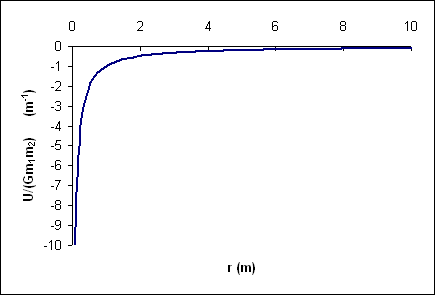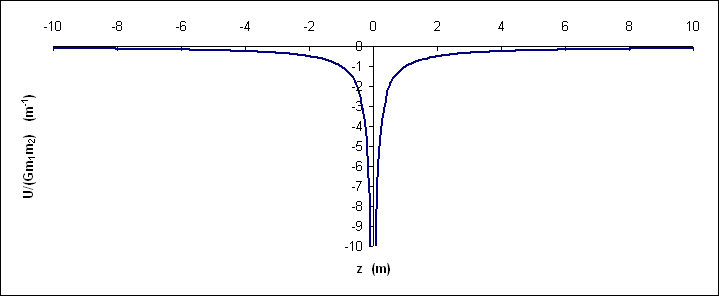|
An interaction between two massive particles resulting in an attractive force exerted on each by the other. The force is proportional to the gravitational constant G = Motivation for ConceptNewton's Law of Universal Gravitation provides an effective description of the movement of objects from submillimeter distances to galactic sizes, and is the dominant force on most (macroscopic) astronomical bodies. Gravitational Force (Newton's Law of Universal Gravitation)Statement of the Law for Point MassesBetween any two point masses (masses m1 and m2, respectively) there will exist an attractive force along the line joining the masses. The force on body 1 due to body 2 will have the form: 
where, G is the gravitational constant equal to: 
r12 is the distance between the two objects and is obtained as the magnitude of the vector difference between the position vector of object 1 and the position vector of object 2. The vector difference is expressed as:

Compatibility with Newton's Laws of MotionNote that the Universal Law of Gravition is consistent with Newton's Third Law of Motion:



The Case of Spherical SymmetryAlthough the form of the Law of Universal Gravitation is strictly valid only for point particles, it is possible to show that for extended objects with a spherically symmetric mass distribution, the Law will hold in the form stated above provided that the positions of the spherical objects are specified by their centers. Gravitational Potential EnergyForm of the Potential EnergyFor two spherically symmetric objects (objects 1 and 2), it is customary to analyze the energy of the gravitational interaction by constructing spherical coordinates with one of the objects at the origin (if one of the objects dominates the mass of the system, its position is typically used as the origin). Newton's Law of Universal Gravitation then takes the form: 
where r is the position of the object that is not placed at the origin. It is also customary to make the assignment that the potential energy of the system goes to zero as the separation goes to infinty: 
Thus, we can define the potential for any separation r as: 
Potential Energy CurveIf the two objects are isolated from other influences, their potential energy curve is then:
This potential energy curve is somewhat misleading, since the potential is spherically symmetric. Thus, although in spherical coordinates, r cannot go negative, if we define a one-dimensional coordinate system by following a radial line through the origin (suppose, for instance, we chose to follow the z axis where z = r cosθ) we would generate a curve:
which indicates the possibility of stable equilibrium when the objects' separation goes to zero. Of course, this is technically impossible for objects of finite size. Gravitational Potential Energy of a SystemIn a system composed of many spherically symmetric objects, the total gravitational potential energy can be found by adding up the contribution from each distinct interaction. It is very important to note that any pair of the bodies experiences only one interaction between them. Take, for example, a system composed of four objects labeled 1, 2, 3 and 4. There are six distinct interactions among these bodies, each of which has an associated potential energy: 
The total potential energy would then be given by: 
It is important to beware of the temptation to double-count. The potential energy U12 is associated with the interaction between objects 1 and 2, it is not associated separately with object 1 and with object 2. |
Overview
Content Tools
Activity

